Kinematics
(projectile motion)
Problem:
A cannon ball is shot from ground level towards a target. Its initial velocity
is v0 = 125 m/s at an angle θ = 37 degrees with the horizontal.
Neglect air resistance.
(a) What are the horizontal and vertical components of the initial velocity?
(b) What is the maximum height of the cannonball? How long does it take to
reach this height?
(c) How long does it take to hit the ground? When it does so, what is its
horizontal distance from its starting point?
(d) What are its height and its horizontal displacement after it has been in
the air for 10 s?
What is its velocity (magnitude and direction) after it has been in the air for
10 s?
Solution:
- Concepts:
Kinematic equations, projectile motion
- Reasoning:
We have motion with constant acceleration.
- Details of the calculation:
(a) v0 = 125 m/s, θ = 37 degrees.
vx(0) = v0cosθ = 99.8 m/s ~100 m/s, vy(0) = v0sinθ
= 75.2 m/s ~ 75 m/s.
(b) vy(tmax-height) = vy(0) - gtmax-height
= 0, tmaxheight = 7.7 s.
vy(t)2 = vy(0)2 - 2gy, vy(0)2
= 2gymax, ymax = 287 m.
(c) Time to hit ground = 2*7.7s = 15.4 s. Distance = v0cosθ*15.4 s
= 1540 m.
(d) y(10 s) = 260 m, x(10 s) = 1000 m.
vx(10 s) = 100 m/s, vy(10 s) = -23 m/s, v = (vx2
+ vy2)½ = 102.6 m/s.
tanθ = vy/vx, θ ~ -13o.
Problem:
Two trucks are parked back to back in opposite directions on a straight,
horizontal road. The trucks quickly accelerate simultaneously to 3.0 m/s in
opposite directions and maintain these velocities. When the backs of the trucks
are 20 meters apart, a boy in the back of one truck throws a stone at an angle
of 40 degrees above the horizontal at the other truck. How fast must he throw,
relative to the truck, if the stone is to just land in the back of the other
truck?
Solution:
- Concepts:
Kinematic, projectile motion
- Reasoning:
The stone's motion is motion in two dimensions with constant acceleration.
Put the origin of the coordinate system at the back of the parked trucks and
let the boy be in the truck moving into the negative x direction. When each
truck has moved 10 m, is speed is v = 3 m/s. Let v be the speed of the
stone relative to the truck.
- Details of the calculation:
The x-component of the stone's speed with respect to the ground is vx
= v cos40o - 3 m/s.
The y-component of the stone's speed with respect to the ground is vy
= v sin40o.
For the stone is to just land in the back of the other truck we need
vxt = 20 m + (3 m/s)t. 0 = vyt - ½gt2, t
= 2vy/g.
Therefore
2vxvy/g = 20 m + (3 m/s) 2vy/g.
vxvy = g 10 m + (3 m/s) vy.
(v cos40o - 3 m/s) v sin40o = g 10 m + (3 m/s) v sin40o.
v2 cos40o sin40o = g 10 m + (6 m/s) v sin40o.
v2 = 199 (m/s)2 + 7.83 (m/s) v.
v = 18.56 m/s.
Problem:
A player tossed a ball at some angle relative to the horizon. The maximum
speed of the ball during the flight was 12 m/sec and the minimum speed was 6
m/sec. What was the maximum height of the ball during the flight? Please
neglect air resistance.
Solution:
- Concepts:
Kinematics, projectile motion
- Reasoning:
The ball executes projectile motion.
- Details of the calculation:
vx
= v0cosθ0 = constant, x = v0cosθ0t,
vy
= v0sinθ0 - gt, y = v0sinθ0t
- ½gt2.
Since vx = constant and vy = 0 when the ball reaches its
maximum elevation,
vmax = v0 = 12 m/s and vmin = v0cosθ0
= 6 m/s. Therefore cosθ0 = ½, θ0 = 60o.
tmax_height
= vy0/g = v0sinθ0/g. ymax
= ½(v0sinθ0)2/g = 5.5 m.
Problem:
A rock is launched from the ground level at a
speed v directed at an angle θ with the horizontal. It is
noticed that some (unknown) time t after the launch, the distance
between the rock and the launch point begins to decrease.
(a)
Find the smallest launch angle θ consistent with this observation.
(b)
Find t, neglecting the air resistance.
Solution:
- Concepts:
Kinematics, projectile motion
- Reasoning:
The rock is a projectile.
For projectile motion we have
x = v cosθ t, y = v sinθ t - ½gt2.
- Details of the calculation:
(a) The distance between the rock and
the launch point is D = (x2 + y2)½
= (v2t2 + g2t4/4 - vgt3sinθ)½.
For 0 < θ < 90o and v > 0 the distance D increases initially. To
find extrema for D we set
dD2/dt = t(g2t2
- 3vgt sinθ + 2v2) = 0.
t2 - 3(v/g) sinθ t + 2v2/g2
= 0, t = [3v/(2g)][sinθ ± (sin2θ - 8/9)½].
If
sin2θ > 8/9 or θ > 70.5287o, then two extrema exist.
The figure below shows a plot of D versus t for v = 10 m/s and a launch
angle smaller, equal, or greater than the critical angle θ > 70.5287o.
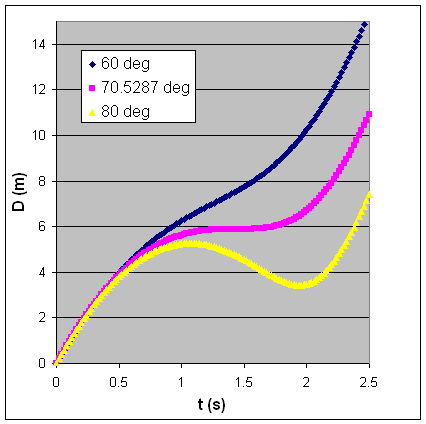
The smallest launch angle θ consistent with the observation is just greater
than 70.5287o.
(b) t = t1 = [3v/(2g)][sinθ - (sin2θ
- 8/9)½] is the maximum we are looking for. For t > t1
D decrease and for
t > t2 = [3v/(2g)][sinθ + (sin2θ
- 8/9)½] it increases again.
The rock hits the ground at t = 2vsinθ/g.
Problem:
Two points, A and B, are located on the ground a certain distance d apart.
Two rocks are launched simultaneously from points A and B, with equal speeds but
at different angles. Each rock lands at the launch point of the other.
Knowing that one of the rocks is launched at an angle θ0 > 45o,
find the minimum distance between the rocks during the flight in terms of d and
θ0?
Solution:
- Concepts:
Kinematics, projectile motion
- Reasoning:
We have to find the position of both rocks as a function
of time.
The range of a projectile launched with speed v0 at
an angle θ0 with respect to the horizontal x-axis is d = v02sin(2θ0)/g.
For two projectile launched with the same speed v0 to have the
same range they have to be launched at angles θ± = π/4 ± θ.
- Details of the calculation:
Assume rock 1 is thrown from point A with
speed v0 and launch angle
θ+ = θ0 = π/4
+ θ towards point B.
Let the origin of the coordinate system be at point
A, let the x-axis point towards B and let the y-axis point upward.
For
rock 1 we have
x1(t) = v0cos(π/4 + θ)t, y1(t)
= v0sin(π/4 + θ)t - ½gt2.
Assume rock 2 is thrown
from point with speed v0 and launch angle θ- = π/4 - θ
towards point A.
For rock 2 we have
x2(t) = d - v0cos(π/4
- θ)t, y2(t) = v0sin(π/4 - θ)t - ½gt2.
Let the distance between the rocks be L(t).
L2(t) = (x2(t)
- x1(t))2 + (y2(t) - y1(t))2
= v02t2(d/(v0t) - cos(π/4 - θ) -
cos(π/4 + θ))2 + v02t2(sin(π/4 -
θ) - sin(π/4 + θ))2
= v02t2(d/(v0t)
- cos(π/4)cos(θ) - sin(π/4)sin(θ) - cos(π/4)cos(θ) + sin(π/4)sin(θ))2
+ v02t2(sin(π/4)cos(θ) - cos(π/4)sin(θ)
- sin(π/4)cos(θ) - cos(π/4)sin(θ))2
= 4v02t2(d/(2v0t)
- cos(π/4)cos(θ))2 + 4v02t2cos2(π/4)sin2(θ)
= d2 + 4v02t2cos2(π/4)(cos2(θ)
+ sin2(θ)) - 4v02t2dcos(π/4)cos(θ)/(v0t)
= d2 + 2v02t2 - 4v0tdcos(π/4)cos(θ).
To find the time at which L2(t) has a minimum, set
dL2(t)/dt
= 4v02t - 4v0dcos(π/4)cos(θ) = 0.
tmin
= dcos(π/4)cos(θ)/v0.
L2(tmin) = d2
+ d2cos2(θ) - 2d2cos2(θ) = d2
- d2cos2(θ).
Lmin = dsin(θ) = dsin(θ0
- π/4) is the minimum distance between the rocks.
Problem:
A catapult set on the ground can launch a rock a maximum horizontal distance
L. What would be the maximum horizontal launch distance if the catapult is
set on a platform moving forward with constant speed equal to the launch speed
of the rock?
Neglect the air resistance and assume that the rock is launched
from the ground level in both cases.
Solution:
- Concepts:
Kinematic equations, projectile motion
- Reasoning:
We have motion with constant acceleration.
- Details of the calculation:
Let θ0 be the launch angle
with respect to the horizontal. (vx = v cosθ0, vy
= v sinθ0)
The range of a projectile is R = (v02sin2θ0)/g.
For the stationary catapult: Rmax = v02/g
= L, v0 = (gL)1/2. (θ0 = 45o)
For the moving catapult: R = (v02sin2θ0)/g
+ v0t.
t = 2vy/g = 2v0sinθ0/g.
R = (v02sin2θ0)/g + 2v02sinθ0/g,
dR/dθ0 = 0 --> cos2θ0 = -cosθ0. θ0
= 600.
R = (v02/g)[sin2θ0 +
2sinθ0]
= L 3√3/2.
Problem:
Consider a lawn sprayer consisting
of a spherical cap (α0
= 45o) provided with a large number of equal holes through which
water is ejected with speed v0. The lawn is not evenly sprayed
if the holes are evenly spaced. How must the number of holes per unit
area, r(α),
be chosen to achieve uniform spraying of a circular area? Assume the
radius of the sprinkler cap is very much less than the radius of the area to be
sprayed, and the surface of the cap is at the level of the lawn.

Solution:
- Concepts:
Kinematics, projectile motion
- Reasoning:
The drops are projectiles.
They execute motion in more than one dimension motion with constant
acceleration. This acceleration is directed downward and has magnitude g.
A drop sprayed from an angle a travels a distance R(α). We want to find
this range R in term of α.
We use
vy0 = v0cosα,
vx0 = v0sinα,
x = x0 + vx0t,
y = y0 + vy0t - ½gt2,
and substitute
0 = 0 + v0(cosα)t - (½gt2), t = 2v0cosα
/g
to solve for
R = x(t) = v0(sinα)t = v0(sinα)2v0(cosα)/g
= v02(sin2α )/g.
- Details of the calculation:
Drops
sprayed from any angles between α
and α + dα fall on an area 2πRdR between R and R + dR.
The number of
drops sprayed from angles between α and α + dα is proportional to ρ(α)2πr2capsin
α dα.
We want
[ρ(α)2πr2capsinα
dα]/[2πRdR]
= const,
or
(ρ(α)sinα)/(RdR/dα)
= const.
dR/dα = 2v02(cos2α)/g.
Therefore
ρ(α
)(sinα)/(cos2α
sin2α)
= const,
or
ρ(α
) is proportional to
sin(4α)
/sinα.
Problem:
A particle is launched with velocity v = 2 ft/s
j along the ridge
of
a roof, but the equilibriums is unstable and it immediately starts
accelerating down the right side of the roof. Using the coordinate
system in the figure and neglecting friction, what are the particle's
x- and y-coordinates when it hits the ground?
Use the following measurements: |
Roof Rise: zR = 4 ft; Roof Width: xR= 24 ft; Roof Length:
yR = 24 ft;
Wall Height: zW = 8 ft; g = 32 ft/s2.

Solution:
- Concepts:
Kinematics, motion with piecewise constant acceleration, energy conservation
- Reasoning:
The forces acting on the particle are gravity and the normal force of the roof.
The motion in the xz plane is independent of the motion with constant vy
in the y-direction.
- Details of the calculation:
Consider only the motion in the xz plane: mg∆h = ½mv2. (v2
= vx2 + vy2)
As long as the particle is in contact the roof: a = gsinθ. sinθ = 4/(160)½
= 0.316.
For the motion to the edge of the roof: v1 = (2g zR)½
= 16 ft/s v1 = gsinθ t1, t1 = 1.58 s.
[Check that the particle stays on the roof during the time interval t1.
During time t1, the particle travels a distance d = 2 ft/s *t1
= 3.16 ft in the y direction, which is less than yR. The particle
stays on the roof. At the edge of the roof the particle's velocity is
v = g sinθ cosθ t1
i - g sinθ sinθ t1
k
+ 2 ft/s j. =15.18 ft/s i - 5.06 ft/s
k + 2 ft/s
j.]
The particle contacts the floor after an additional time t2. 8ft - v1zt2
- ½gt22 = 0 t2 = 0.568 s.
The particle's x and y coordinates at time t2 are x = 12 ft + g sinθ
cosθ t1 t2 = 20.62 ft,
y = 3.16 ft + 2 ft/s (t2
- t1) = 4.3 ft.
Problem:
In a carnival game, you have to throw a ball with speed v0 at an
angle θ in order to hit a target on the other side of the platform, located a
distance h away. The platform is inclined at an angle φ. Find the angle θ in
terms of the other variables.
Solution:
- Concepts:
Kinematics, projectile motion
- Reasoning:
Orient the x and y axes of your coordinate system as shown.
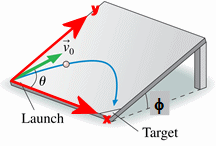
The net force acting on the ball in a direction perpendicular
to the xy-plane is zero.
In the x-y plane ax = 0, ay = -gsinφ = -g'.
- Details of the calculation:
The range of the ball is h = (v02sin2θ)/g'.
sin2θ = h gsinφ/v02, θ = ½ sin-1(h gsinφ/v02).
Problem:
A tree trunk lies on the ground. The trunk has a shape of a cylinder with
radius R. A flea attempts to jump over the trunk. What is the minimum initial
speed v that enables the flea to reach the other side? Assume that the flea is
intelligent enough to select the optimal take-off point on the ground.
Consider two cases.
(a) The flea is allowed to slide on the frictionless trunk.
(b) The flea is not allowed to slide on the trunk and must clear the trunk.
Solution:
- Concepts:
Kinematics, projectile motion
- Reasoning:
(a) Imagine the flea sitting on top of the trunk. This is an unstable
equilibrium and the slightest perturbation will cause it to slide off. Its
kinetic energy when reaching the ground will be
½mv2 = 2mgR. The motion may be reversed.
(b) The flea's trajectory must be a parabola as shown.
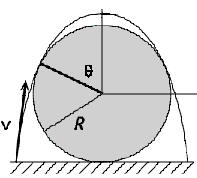
- Details of the calculation:
(a) The flea must jump with a speed greater than v = 2(gR)½.
(b) Let the parabolic arc of the flea be tangent to the trunk at an angle θ
from the top of the trunk.
The velocity of the flea at this point is vθ = (vθcosθ,
vθsinθ).
The conditions for the parabola to reach its maximum over the center of
trunk are
vθcosθ t = r sinθ, vθsinθ = gt for some t.
(vθy must be zero at the top.)
These give vθ2 = rg/cosθ.
Let v be the speed with which the flea jumps from the ground. Then the
energy at the ground is
½ mv2 = mg(r + r cosθ) + ½mrg/cosθ = mgr(1 + cosθ + 1/(2cosθ)).
Minimizing this function of cosθ yields cosθ = 1/√2, θ = 45o.
The minimum initial speed is v2 = 2gr(1 + √2), v = 2.197 (gr)½.
Problem:
A marble bounces down stairs in a regular manner, hitting each
step at the same place and bouncing the same height above each step.
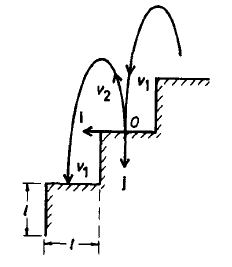
The stair height equals its depth (tread = rise) and the
coefficient of restitution ε is given. Find the necessary
horizontal velocity and bounce height.
(The coefficient of restitution is defined as ε = -vf/vi,
where vf and vi are the vertical velocities just after and
before the bounce. respectively).
Solution:
- Concepts:
Kinematics, collisions, motion with constant
acceleration
- Reasoning:
The horizontal component of the velocity of the marble, vh, is
constant. Let vi and vf denote the magnitudes of
the vertical components of the velocity of the marble just before and just
after a bounce, respectively. Since the conditions at each step are
exactly the same, vi and vf are also constants.
The relationship between the magnitudes of v1 = vhi
- vij and v2 = vhi + vfj
is found from the conservation of mechanical energy in a conservative field.
½mv22 + mgl = ½mv12.
- Details of the calculation:
v22 + 2gl = v12. vi2
- 2gl = vf2 = ε2vi2.
vi2 = 2gl/(1 - ε2).
What is the time between bounces?
Starting with a vertical velocity vf, the time to reach the point
where the vertical velocity is zero is t1 = vf/g.
The time to accelerate downward from this point and reach a vertical
velocity -vi is t2 = |vi|/g.
The total time between bounces is t = t1 + t2 = (vf +
|vi|)/g = l/vh,
since during this time the marble has to cover a horizontal distance l.
vh = gl/(vf + |vi|) = gl/[(1 + ε)|vi|] = (gl/2)½[(1 - ε)/(1 + ε)]½.
The bounce height h is found from conservation of energy.
½mvf2 = mgh, h = vf2/(2g) =
ε2l/(1 - ε2).
(a) An astronaut on a strange
planet finds that she can jump a maximum horizontal distance of 15 m if her
initial speed is 3 m/s. What is the free-fall acceleration on the planet?
(b) How much work is required to raise a 100 g block to a
height of 200 cm and simultaneously give it a velocity of 300 cm/sec?
An plane, inclined at θ = 20o, touches a wall as shown in the
picture. You drop a small, perfectly elastic ball from a height h = 1.5 m
onto the onto the plane. The ball falls from rest. You do not move
your hand. At what distance d from the wall do you have to drop it so that
it bounces back into your hand?
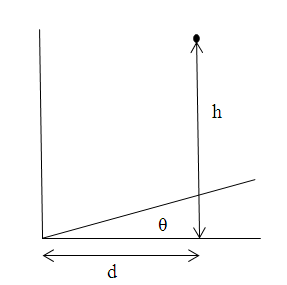
A wheel of radius b is rolling along a muddy road with a speed v. Particles
of mud attached to the wheel are being continuously thrown off from all points
of the wheel. If v2 > 2bg, where g is the acceleration of gravity,
find the maximum height above the road attained by the mud, H = H(b,v,g).






